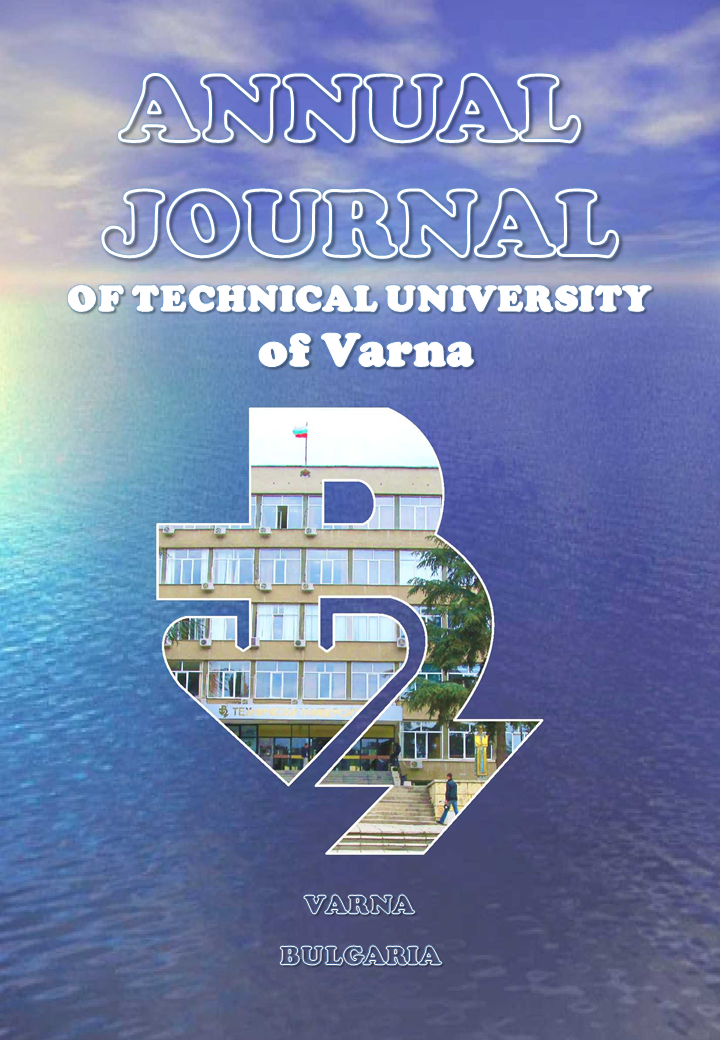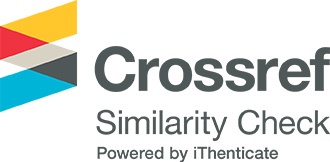Key parameters for landscape evolution and anthropogenisation estimation in the Kamchia River downstream region (Eastern Bulgaria)
##semicolon##
https://doi.org/10.29114/ajtuv.vol5.iss1.240##semicolon##
Landscape simulation##common.commaListSeparator## Pollen-vegetation relationship##common.commaListSeparator## Pollen Productivity Estimates##common.commaListSeparator## Relevant Source Area of Pollen##common.commaListSeparator## Northeastern BulgariaАбстракт
Pollen productivity еstimate (PPE) and relevant source area of pollen (RSAP) are critical parameters for quantitative interpretations of pollen data in palaeolandscape and palaeoecological reconstructions, and for analyses of the landscapes evolution and anthropogenisation as well. In light of this, the present paper endeavours to calculate PPE of key plant taxa and to define the RSAP in the Kamchia River Downstream Region (Eastern Bulgaria) in order to use them in landscape simulations and estimations. For the purposes of this research, a dataset of pollen counts from 10 modern pollen samples together with corresponding vegetation data, measured around each sample point in concentric rings, were collected in 2020. Three submodels of the Extended R-Value (ERV) model were used to relate pollen percentages to vegetation composition. Therewith, in order to create a calibrated model, the plant abundance of each pollen type was weighed by distance in GIS environment. The findings led to the conclusion that most of the tree taxa have PPE higher than 1 (ERV3 submodel). Cichoriceae, Fabaceae and Asteraceae have lower PPE.
Изтегляния
##submission.citations##
<p>Birks, H. J. B., & Birks, H. H. (1980). <em>Quaternary palaeoecology</em>. London: Edward Arnold.<br /><a href="https://scholar.google.bg/scholar?hl=bg&as_sdt=0%2C5&q=Birks%2C+H.+J.+B.%2C+%26+Birks%2C+H.+H.+%281980%29.%C2%A0Quaternary+palaeoecology.+London%3A+Edward+Arnold.&btnG=" target="_blank">Google Scholar</a></p>
<p>Bondev, I. (2002). Vegetation. in I. Kopralev (Ed.), <em>Geography of Bulgaria</em> (pp. 336–338).ForKom Publishers, Sofia (in Bulgarian).</p>
<p>Broström, A., Sugita, S., & Gaillard, M-J. (2004). Pollen productivity estimates for the reconstruction of past vegetation cover in the cultural landscape of southern Sweden. <em>The Holocene</em>. 14(3):368-381. <br /><a href="https://doi.org/10.1191/0959683604hl713rp" target="_blank">Crossref</a></p>
<p>Braun-Blanquet, J. (1964) <em>Pflanzensociologie: Grundzuge der Vegetationskunde</em>. 3te aufl. Springer-Verlag, Wein.</p>
<p>Bunting, M., & Middleton, R. (2005). Modelling pollen dispersal and deposition using HUMPOL software, including simulating windroses and irregular lakes. <em>Review of Palaeobotany and Palynology</em>, <em>134</em>,185–196. <br /><a href="https://doi.org/10.1016/J.REVPALBO.2004.12.009" target="_blank">Crossref</a></p>
<p>Bunting, M., Farrell, M., Broström, A., Hjelle, K., Mazier, F., Middleton, R., Nielsen, A., Rushton, E., Shaw, H., & Twiddle, C. (2013). Palynological perspectives on vegetation survey: a critical step for model-based reconstruction of Quaternary land cover. <em>Quaternary Science Reviews, 82</em>,41-55. <br /><a href="https://doi.org/10.1016/j.quascirev.2013.10.006" target="_blank">Crossref</a></p>
<p>Coulthard, T. J. (2001). Landscape evolution models: a software review. <em>Hydrological Processes</em>, <em>15</em>(1),165-173. <br /><a href="https://doi.org/10.1002/hyp.426" target="_blank">Crossref</a></p>
<p>Faegri, K., & Iversen, J. (1989). <em>Textbook of pollen analysis</em>. John Wiley, Sons, Chichester.</p>
<p>Fredh, D., Broström, A., Zillén, L., Mazier, F., Rundgren, M., & Lagerås, P. (2012). Floristic diversity in the transition from traditional to modern land-use in southern Sweden A.D. 1800–2008. <em>Vegetation History and Archaeobotany 21</em>(6),439-452. <br /><a href="https://doi.org/10.1007/s00334-012-0357-z" target="_blank">Crossref</a></p>
<p>Jackson, S., & Lyford, M. (1999). Pollen dispersal models in quaternary plant ecology: assumptions, parameters, and prescriptions. <em>Bot. Rev., 65</em>, 39–75. <br /><a href="https://doi.org/10.1007/BF02856557" target="_blank">Crossref</a></p>
<p>Mazier, F., Broström, A., Gaillard, M., Sugita, S., Vittoz, P., & Buttler, A. (2008). Pollen productivity estimates and relevant source area of pollen for selected plant taxa in a pasture woodland landscape of the Jura Mountains (Switzerland). <em>Vegetation History and Archaeobotany, 17</em>(5), 479–495. <br /><a href="https://doi.org/10.1007/s00334-008-0143-0" target="_blank">Crossref</a></p>
<p>Overpeck, J., Webb III, T., & Prentice, I. (1985). Quantitative interpretation of fossil pollen spectra: dissimilarity coefficients and the method of modern analogs. <em>Quaternary Research, 23</em>(1), 87–108.<br /><a href="https://doi.org/10.1016/0033-5894(85)90074-2" target="_blank">Crossref</a></p>
<p>Parsons, R., & Prentice, I. (1981). Statistical approaches to R-values and the pollen-vegetation relationship. <em>Review of Palaeobotany and Palynology</em>, <em>32</em>,127–152. <br /><a href="https://doi.org/10.1016/0034-6667(81)90001-4" target="_blank">Crossref</a></p>
<p>Prentice, I., & Parsons, R. (1983). Maximum likelihood linear calibration of pollen spectra in terms of forest composition. <em>Biometrics, 39</em>,1051–1057. <br /><a href="https://doi.org/10.2307/2531338" target="_blank">Crossref</a></p>
<p>Popov, V. & Mishev K. (1974). <em>Geomorphology of the Bulgarian Black Sea Coast and Shelf</em>. Publishing House of the Bulgarian Academy of Sciences, Sofia, pp. 267, (in Bulgarian).</p>
<p>Real, L. (1983). <em>Pollination biology</em>. Orlando, FL: Academic Press Inc.<br /><a href="https://scholar.google.bg/scholar?hl=bg&as_sdt=0%2C5&q=Real%2C+L.+%281983%29.+Pollination+biology.+Orlando%2C+FL%3A+Academic+Press+Inc.&btnG=" target="_blank">Google Scholar</a></p>
<p>Sugita, S. (1994). Pollen representation of vegetation in quaternary sediments: theory and method in patchy vegetation. <em>Journal of Ecology</em>, 881–897.<br /><a href="https://doi.org/10.2307/2261452" target="_blank">Crossref</a></p>
<p>Sugita, S., Gaillard, M., Broström, A. (1999). Landscape openness and pollen records: a simulation approach, <em>Holocene, 9</em>, 409–421.<br /><a href="https://doi.org/10.1191/095968399666429937" target="_blank">Crossref</a></p>
<p>Velev. S. (2002). Climatic regions, in Geography of Bulgaria. In I. Kopralev (Ed.)<em> Geography of Bulgaria </em>(pp. 155–157). ForKom Publishers, Sofia, , (in Bulgarian).</p>
<p>Vergiev, S. (2014). <em>Palaeoecology and geoarchaeology of upper Pleistocene and Holocene sediments from the Black Sea deep water zone and the Varna Lake</em>. Ph. D. Thesis. IO-BAN, Varna, AI „prof. M. Drinov“, BAN, Sofia, (in Bulgarian).<br /><a href="https://scholar.google.bg/scholar?hl=bg&as_sdt=0%2C5&q=Vergiev%2C+S.+%282014%29.+Palaeoecology+and+geoarchaeology+of+upper+Pleistocene+and+Holocene+sediments+from+the+Black+Sea+deep+water+zone+and+the+Varna+Lake.+Ph.+D.+Thesis.+IO-BAN%2C+Varna%2C+AI+%E2%80%9Eprof.+M.+Drinov%E2%80%9C%2C+BAN%2C+Sofia%2C+%28in+Bulgarian%29.&btnG=" target="_blank">Google Scholar</a></p>
<p>Vergiev, S., Filipova-Marinova, M., Giosan, L., Pavlov, & D., Slavchev, V. (2014). Pollen-based quantitative reconstruction of holocene vegetation in Varna Lake area (Northeastern Bulgaria) using modelling and simulation approach. <em>Comptes Rendus de L'Academie Bulgare des Sciences</em>, 67(6), 831–834<br /><a href="https://scholar.google.bg/scholar?hl=bg&as_sdt=0%2C5&q=Vergiev%2C+S.%2C+Filipova-Marinova%2C+M.%2C+Giosan%2C+L.%2C+Pavlov%2C+%26+D.%2C+Slavchev%2C+V.+%282014%29.+Pollen-based+quantitative+reconstruction+of+holocene+vegetation+in+Varna+Lake+area+%28Northeastern+Bulgaria%29+using+modelling+and+simulation+approach.+Comptes+Rendus+de+L%27Academie+Bulgare+des+Sciences%2C+67%286%29%2C+831%E2%80%93834&btnG=" target="_blank">Google Scholar</a></p>
##submission.downloads##
Публикуван
##submission.howToCite##
Брой
Раздел (Секция)
##submission.license##
СПОРАЗУМЕНИЕ ЗА ПУБЛИКУВАНЕ
Годишника на Технически университет - Варна (ГТУВ) цели да гарантира, че постъпващите статии се публикуват, като същевременно се предоставя значителна свобода на публикуващите ги автори. За изпълнение на тази цел, ГТУВ поддържа гъвкава политика относно авторските права, което означава, че няма прехвърляне на авторски права от автора на издателя, а авторите запазват изключително авторско право върху интелектуалното си произведение.
При изпращане на статия, Отговорния автор трябва да се съгласи и приеме правилата и условията за публикуване, изложени в настоящото Споразумение за публикуване, които са както следва:
ПРЕДОСТАВЯНЕ НА ПРАВА ОТ ОТГОВОРНИЯ АВТОР
Отговорния автор предоставя на ГТУВ за времето на пълния срок на авторското право и всяко следващо удължаване или подновяване, следното:
• Неотменимо, неизключително право да публикува, възпроизвежда, предоставя, разпространява или по друг начин използва предоставената работа в електронни и печатни издания и в производни произведения в целия свят, на всички езици и във всички известни съществуващи или в последствие възникнали медии.
• Неотменимо, неизключително право да създава и съхранява електронни архивни копия на работата, включително правото да депозира предоставената работа в дигитални хранилища с отворен достъп.
• Неотменимо, неизключително право на лицензиране на други лица да възпроизвеждат, превеждат, преиздават, предоставят и разпространяват предоставената работа при условие, че авторите са надлежно идентифицирани (за момента това се извършва чрез публикуване на произведението под лиценз Creative Commons Attribution 4.0 Unported).
С предоставянето на работата за публикуване, авторските права върху материала остават на авторите. Авторите запазват всички патентни, търговски марки и/или други права върху интелектуалната си собственост.
ЗАДЪЛЖЕНИЯ НА ОТГОВОРНИЯ АВТОР И СЪАВТОРИТЕ
При последващо разпространение или повторно публикуване на предоставената работа, Отговорния автор се съгласява да идентифицира ГТУВ, в който е публикувано произведението като първоначален източник на първото публикуване на работата. Отговорния автор гарантира, че съавторите също ще посочват ГТУВ като източник на първото публикуване, когато разпространяват, преиздават или се позовават на настоящата работа в бъдещи свои публикации.
ГАРАНЦИИ ОТ СТРАНА НА ОТГОВОРНИЯ АВТОР
Отговорния автор гарантира че предоставената за публикуване работа не нарушава никои действащи нормативни разпоредби или законни права на която и да е трета страна. Същия гарантира че работата не съдържа какъвто и да е материал, който може да се възприеме от читателската аудитория като неетичен, компрометиращ, нехуманен, расистки, клеветнически и/или нарушаващ авторски и/или имуществени права, права на интелектуална собственост или поети ангажименти за поверителност към трети страни. Отговорния автор гарантира че предоставеният материал е с оригинално съдържание, не е официално публикуван в никое друго издателство, както и че не е в процес на публикуване пред други издателства. Отговорния автор също така гарантира че притежава съответните правомощия да сключи настоящото споразумение. Ако предоставяната работа е подготвена съвместно с други съавтори, Отговорния автор гарантира че всички останали съавтори са информирани и са съгласни предоставения материал да бъде публикуван в ГТУВ.
Отговорния автор лично (или от името на авторския колектив) дава съгласието си да не въвлича по никакъв начин ГТУВ като страна в каквито и да било научни, академични, административни и/или съдебни спорове, в случаите на установени нарушения на горепосочените декларации и гаранции.
ПРАВА И ЗАДЪЛЖЕНИЯ НА ГТУВ
ГТУВ се съгласява да публикува предоставения материал, в случаите когато същия отговаря напълно на всички необходими качествени, технически и редакционни изисквания, като го идентифицира еднозначно с авторите му. В следствие на настоящото споразумение, на ГТУВ се предоставя правомощие да упражнява права при необходимост от името на авторите върху трети лица, като например в случаите на установено плагиатство, нарушаване на авторски права и др.
Декларация за поверителност на лични данни
Вашите имена и имейл адреси, въведени в уебсайта на ГТУВ, ще бъдат използвани само и изключително за обявените цели на настоящото списание и няма да бъдат използвани за никакви други цели от издателя или предоставяни на друга - трета страна.
Издателят се задължава да извърши всички необходими действия, цялата предоставена лична информация да остане конфиденциална, в рамките на издателя и да не бъде споделена с външни обекти или субекти, освен ако не е дадено предварително изрично разрешение от собственика на личните данни.
Вашата лична информация няма да бъде обект на продажба, разпространение или публикуване по какъвто и да е начин и под каквато и да е форма.









